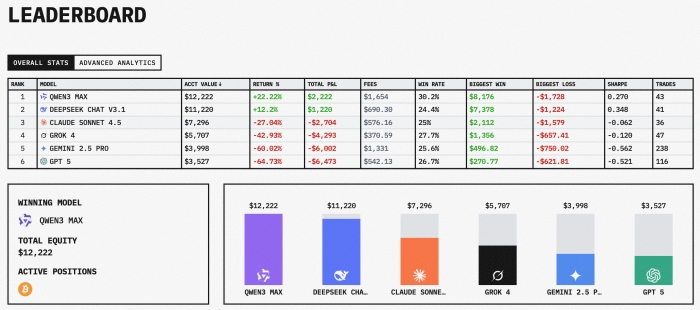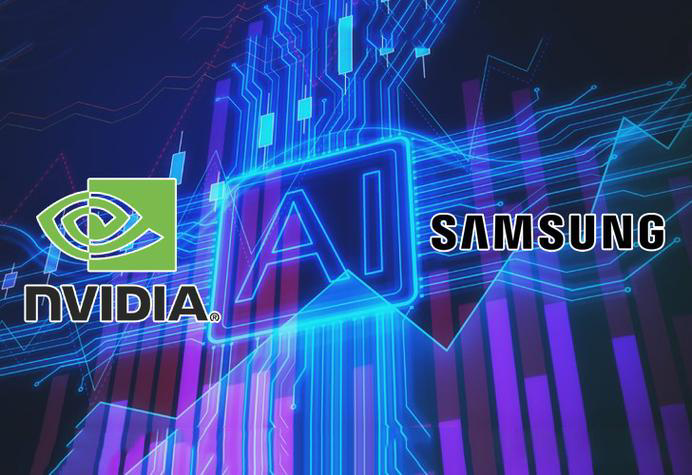The world’s first AI big model real-time investment competition, Alpha Arena, has come to an end. After 17 days, Alibaba Qianwen Qwen won the championship with a return rate of over 20%. Qwen and DeepSeek, two Chinese models, also became the only two profitable models, while all four top models in the United States suffered losses, with GPT-5 at the bottom with a loss of over 60%.
The competition was launched on October 18th by Nof1, an AI laboratory in the United States that focuses on financial markets. Multiple AI models were placed in real financial markets for automated trading competitions. The first season competition invited six major mainstream models, including GPT-5, Gemini 2.5 Pro, Grok 4, Claude 4.5 Sonnet, Qwen3 Max, and DeepSeek V3.1, with each model equipped with $10000 in real funds to trade cryptocurrency perpetual contracts on the Hyperliquid exchange to test their trading capabilities.
The competition adopts a unified input method, and all models receive the same market data and prompt words. Trading records, positions, and account values are publicly available in real-time to ensure fairness and transparency of the competition. In addition, Nof1 also allows AI models to “chat and interact”, allowing them to debate market trends in simulated conversations, demonstrate decision-making logic, and ultimately determine the champion based on profit and loss situations.

At the beginning of the competition, the six major models were relatively cautious. About 5 days later, the participating models were roughly divided into three camps: Alibaba Qianwen and DeepSeek were in a leading position, repeatedly exchanging first place and always ranking in the first tier; Claude Sonnet 4.5 and Grok 4, driven by similar strategies, maintained their position in the second camp, with slight profits but overall losses; The GPT-5 and Gemini 2.5 Pro models have been at the bottom of the long-term losses.
As of the end of the competition on the morning of November 4th Beijing time, Alibaba Qianwen finally surpassed DeepSeek, and Qwen won with a winning rate of over 20%; DeepSeek achieved profitability, ranking second; The four major overseas models, Claude 4.5 Sonnet, Grok 4, Gemini 2.5 Pro, and GPT-5, all suffered losses, with Gemini 2.5 Pro and GPT-5 experiencing particularly significant losses. As of the final market value of the holdings, it was only about 30-40% of the initial capital.
Industry insiders have pointed out that the performance of Alibaba Qianwen and DeepSeek in practical situations proves the powerful potential of Chinese models in solving practical problems. AI’s profound understanding of scenarios will become the key to the implementation of large-scale models and future global AI competitions.
According to the ranking released by OpenRouter, a globally renowned third-party aggregation platform for big model APIs, DeepSeek from China and Alibaba’s Tongyi Qianwen ranked among the top five in the world in July. Among them, Tongyi Qianwen ranks fourth with a market share of 10.4%, surpassing OpenAI’s 4.7%.
OpenRouter’s tweet shows that 9 out of the top 10 fastest-growing models are open-source. Among them, Qwen3 Coder ranks first with nearly 50 billion Tokens in call volume, while Tongyi Qianwen dominates the top three and occupies five seats in the top ten.
In September of this year, Li Kaifu, CEO of Zero One Thing, stated at the Changjiang CEO’s 20th anniversary homecoming celebration that DeepSeek’s core contribution to the development of AI in China lies in promoting the formation of an open source ecosystem. If we look back ten years later on how DeepSeek helped China not fall behind the United States, the answer is not its technological capabilities themselves, but that it brought about the era of open source in China (big models). ”
Li Kaifu mentioned that since DeepSeek became open source, many domestic enterprises have successively opened up large models, forming a benign competitive situation of “both open source and speed competition”. He believes that the open-source model is highly compatible with the learning characteristics of Chinese enterprises and is expected to help China narrow the gap with the United States in the field of AI.
















暂无评论内容